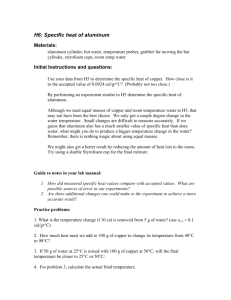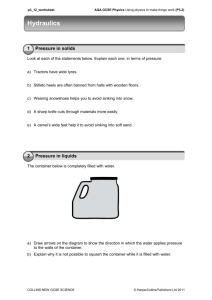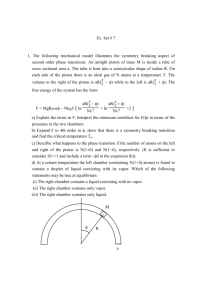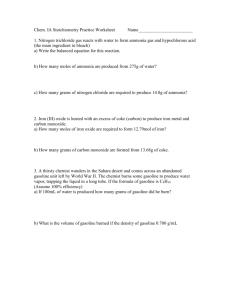2010S exam 1
advertisement
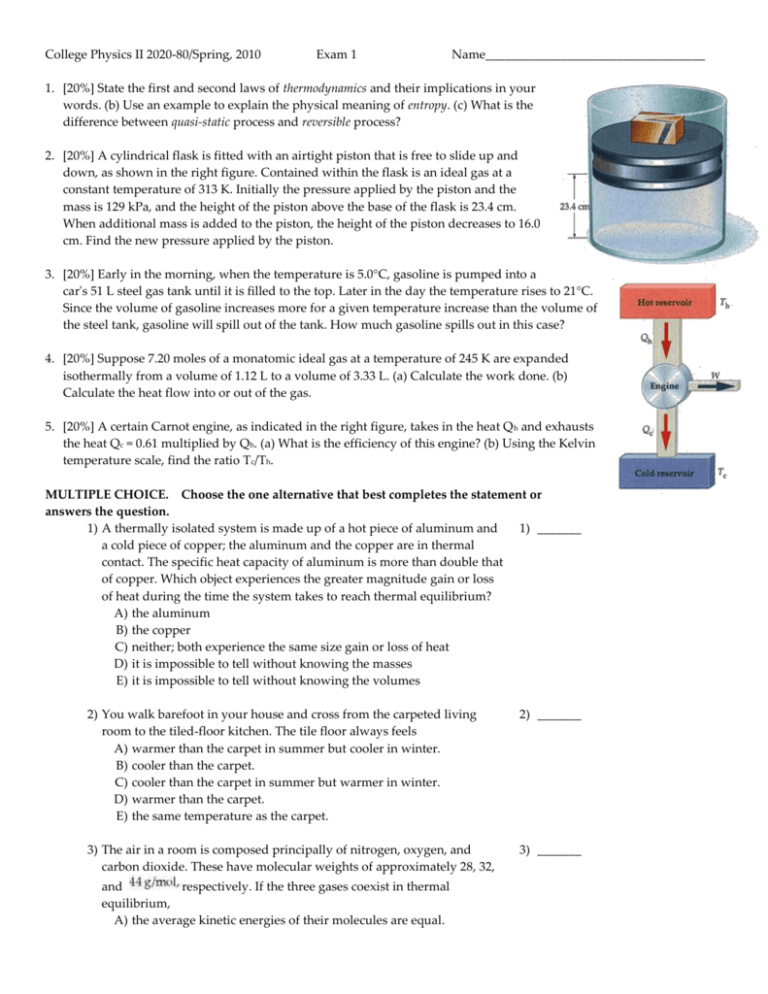
College Physics II 2020-80/Spring, 2010 Exam 1 Name___________________________________ 1. [20%] State the first and second laws of thermodynamics and their implications in your words. (b) Use an example to explain the physical meaning of entropy. (c) What is the difference between quasi-static process and reversible process? 2. [20%] A cylindrical flask is fitted with an airtight piston that is free to slide up and down, as shown in the right figure. Contained within the flask is an ideal gas at a constant temperature of 313 K. Initially the pressure applied by the piston and the mass is 129 kPa, and the height of the piston above the base of the flask is 23.4 cm. When additional mass is added to the piston, the height of the piston decreases to 16.0 cm. Find the new pressure applied by the piston. 3. [20%] Early in the morning, when the temperature is 5.0°C, gasoline is pumped into a car's 51 L steel gas tank until it is filled to the top. Later in the day the temperature rises to 21°C. Since the volume of gasoline increases more for a given temperature increase than the volume of the steel tank, gasoline will spill out of the tank. How much gasoline spills out in this case? 4. [20%] Suppose 7.20 moles of a monatomic ideal gas at a temperature of 245 K are expanded isothermally from a volume of 1.12 L to a volume of 3.33 L. (a) Calculate the work done. (b) Calculate the heat flow into or out of the gas. 5. [20%] A certain Carnot engine, as indicated in the right figure, takes in the heat Q h and exhausts the heat Qc = 0.61 multiplied by Qh. (a) What is the efficiency of this engine? (b) Using the Kelvin temperature scale, find the ratio Tc/Th. MULTIPLE CHOICE. Choose the one alternative that best completes the statement or answers the question. 1) A thermally isolated system is made up of a hot piece of aluminum and 1) _______ a cold piece of copper; the aluminum and the copper are in thermal contact. The specific heat capacity of aluminum is more than double that of copper. Which object experiences the greater magnitude gain or loss of heat during the time the system takes to reach thermal equilibrium? A) the aluminum B) the copper C) neither; both experience the same size gain or loss of heat D) it is impossible to tell without knowing the masses E) it is impossible to tell without knowing the volumes 2) You walk barefoot in your house and cross from the carpeted living room to the tiled-floor kitchen. The tile floor always feels A) warmer than the carpet in summer but cooler in winter. B) cooler than the carpet. C) cooler than the carpet in summer but warmer in winter. D) warmer than the carpet. E) the same temperature as the carpet. 2) _______ 3) The air in a room is composed principally of nitrogen, oxygen, and carbon dioxide. These have molecular weights of approximately 28, 32, 3) _______ and respectively. If the three gases coexist in thermal equilibrium, A) the average kinetic energies of their molecules are equal. B) the rms speeds, in increasing order are nitrogen, oxygen, and carbon. C) the kinetic energies, in increasing order are nitrogen, oxygen, and carbon. D) the rms speeds of their molecules are equal. E) the kinetic energies, in increasing order are carbon, oxygen, and nitrogen. 4) The point in the phase diagram where the fusion curve, the vapor pressure curve, and the sublimation curve join is called the A) double point. B) melting point. C) triple point. D) boiling point. E) critical point. 4) _______ 5) When a gas expands adiabatically, A) the internal energy of the gas increases. B) the internal energy of the gas decreases. C) there is no work done by the gas. D) heat flows out of the system. E) work is done on the gas. 5) _______ 6) How much heat is required to raise the temperature of 2 moles of an ideal monatomic gas by 10 C° at constant volume? A) 200 J B) 125 J C) 249 J D) 208 J E) 416 J 6) _______ 7) An ideal monatomic gas undergoes a reversible isothermal expansion, 7) _______ where = 5 . How much work is done by the gas in this process, in terms of the initial pressure and volume? A) /5 B) C) 2.5 D) 5 E) ln(5) 8) An irreversible engine operating between the temperatures of 550 K and 300 K extracts 1200 J of heat from the hot reservoir and produces 450 J of work. How much entropy is created in the process? A) 0.44 J/K B) 0.73 J/K C) 0 J/K D) 0.68 J/K E) 0.32 J/K 8) _______ 1) 2) 3) 4) 5) 6) 7) 8) C B A C B C E E

